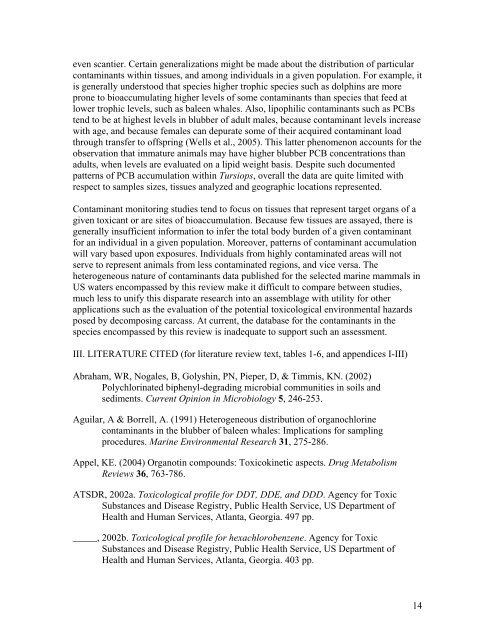Volume III, Appendices EM - National Marine Fisheries Service ...
Volume III, Appendices EM - National Marine Fisheries Service ...
Volume III, Appendices EM - National Marine Fisheries Service ...
You also want an ePaper? Increase the reach of your titles
YUMPU automatically turns print PDFs into web optimized ePapers that Google loves.
even scantier. Certain generalizations might be made about the distribution of particular<br />
contaminants within tissues, and among individuals in a given population. For example, it<br />
is generally understood that species higher trophic species such as dolphins are more<br />
prone to bioaccumulating higher levels of some contaminants than species that feed at<br />
lower trophic levels, such as baleen whales. Also, lipophilic contaminants such as PCBs<br />
tend to be at highest levels in blubber of adult males, because contaminant levels increase<br />
with age, and because females can depurate some of their acquired contaminant load<br />
through transfer to offspring (Wells et al., 2005). This latter phenomenon accounts for the<br />
observation that immature animals may have higher blubber PCB concentrations than<br />
adults, when levels are evaluated on a lipid weight basis. Despite such documented<br />
patterns of PCB accumulation within Tursiops, overall the data are quite limited with<br />
respect to samples sizes, tissues analyzed and geographic locations represented.<br />
Contaminant monitoring studies tend to focus on tissues that represent target organs of a<br />
given toxicant or are sites of bioaccumulation. Because few tissues are assayed, there is<br />
generally insufficient information to infer the total body burden of a given contaminant<br />
for an individual in a given population. Moreover, patterns of contaminant accumulation<br />
will vary based upon exposures. Individuals from highly contaminated areas will not<br />
serve to represent animals from less contaminated regions, and vice versa. The<br />
heterogeneous nature of contaminants data published for the selected marine mammals in<br />
US waters encompassed by this review make it difficult to compare between studies,<br />
much less to unify this disparate research into an assemblage with utility for other<br />
applications such as the evaluation of the potential toxicological environmental hazards<br />
posed by decomposing carcass. At current, the database for the contaminants in the<br />
species encompassed by this review is inadequate to support such an assessment.<br />
<strong>III</strong>. LITERATURE CITED (for literature review text, tables 1-6, and appendices I-<strong>III</strong>)<br />
Abraham, WR, Nogales, B, Golyshin, PN, Pieper, D, & Timmis, KN. (2002)<br />
Polychlorinated biphenyl-degrading microbial communities in soils and<br />
sediments. Current Opinion in Microbiology 5, 246-253.<br />
Aguilar, A & Borrell, A. (1991) Heterogeneous distribution of organochlorine<br />
contaminants in the blubber of baleen whales: Implications for sampling<br />
procedures. <strong>Marine</strong> Environmental Research 31, 275-286.<br />
Appel, KE. (2004) Organotin compounds: Toxicokinetic aspects. Drug Metabolism<br />
Reviews 36, 763-786.<br />
ATSDR, 2002a. Toxicological profile for DDT, DDE, and DDD. Agency for Toxic<br />
Substances and Disease Registry, Public Health <strong>Service</strong>, US Department of<br />
Health and Human <strong>Service</strong>s, Atlanta, Georgia. 497 pp.<br />
_____, 2002b. Toxicological profile for hexachlorobenzene. Agency for Toxic<br />
Substances and Disease Registry, Public Health <strong>Service</strong>, US Department of<br />
Health and Human <strong>Service</strong>s, Atlanta, Georgia. 403 pp.<br />
14
















